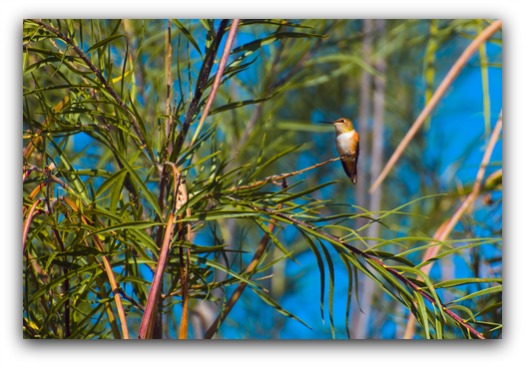Hummingbird Habitat

What’s the optimum hummingbird habitat?
Glad you asked!
Their natural habitat ranges throughout North and South America, from Chile all the way north to Alaska.
Hailing from the Trocholidae family hummingbirds are one of the smallest types of birds.
On average they measure between 3 to 5 inches in physical length.
While small in stature hummingbirds are the Western Hemisphere’s second largest bird species.
There are well over 300 hummingbird species, with 3 from Canada, 15 from America and 50 in Mexico. The largest number comes from Ecuador.
Natural Habitat
Hummingbirds live in various regional latitudes ranging from sea level to about fourteen thousand feet above sea level.
Most hummingbirds love wooded and forested places with numerous flowers. They also like regions with meadows and grasslands. This is why Central and South America have traditionally been the most natural habitat for them.
With that said cool areas, warm areas, large cities and even desert environments can act as their habitats so long as they can find bugs to eat and nectar to drink.
Other habitats that support hummingbirds include marshes, canyons, gardens, backyards and riparian corridors. Riparian corridors are areas of vegetation growing near lagoons, lakes, rivers, streams, etc.
The greatest diversity is found in tropical regions close to the equatorial lands. These areas provide a rich ecological biodiversity suitable for the survival of our favorite birds.
Common US Hummingbirds
As I mentioned above desert areas can be attractive to hummingbirds. This is why you’ll see species such as Anna’s, Costa’s, Broad-tailed, Blue-throated and violet-crowned in areas of the United States like California and Arizona.
On the other hand you’ll see the Ruby-throated species of hummingbirds predominantly on the Eastern side of the US.
Ruby-throats are exciting to watch because they’re so inquisitive. They’re a brilliant flash of red and green as they fly up, down, to the side or backwards, zipping from each food source and rest area. They have no issue feeding from window feeders, as they’ll become used to your human presence.
Creating Your Own Hummingbird Habitat
If you’re like me you’re probably enthused by the idea of creating a hummingbird habitat in your own yard. You simply need to consider factors such as food, shelter, water and nesting that hummingbirds require to live peacefully.
Shelter should consist of thick trees and scrubs that are necessary for their security while thorny bushes provide extra protection for these wonderfully colorful, yet vulnerable small birds. Your trees and bushes also provide them with good nesting areas.
They need high energy and nutritional foods from nectar and the flowers you choose for your garden.
You can add hummingbird feeders to provide a rich and reliable food supplement, as well as attract the spring’s first visitors. A dripper placed in shaded areas enables them to obtain fresh kept water for drinking and they can rub themselves as well to bathe.
Declining Habitats
A concern to me is that hummer habitats have continued to decline in recent years.
One reason is the clearing of land in Mexico in order to allow cattle to graze. Up the Western part of America, states like California, Washington and Oregon keep clearing land to build houses on.
These activities destroy the shrubbery and brush habitats so vital to our friendly, glittering birds.
Anything you and I can do in creating our own backyard hummingbird habitats is crucial.
Subscribe to my updates!
Hummingbirds > Hummingbird Migration > Hummingbird Habitat




